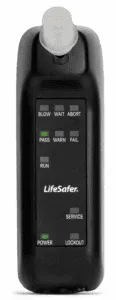Using Your Lifesafer Ignition Interlock Device
Your LifeSafer car breathalyzer is installed and your license is reinstated. You are ready to start your ignition interlock program to drive. At the time of your installation, the technician gave you a training checklist that is state-specific and a device manual. Make sure to keep these items in your car so you have them available for review. If you have any questions, ask your installation technician at the time of install or contact your monitoring authority for clarification. You can also refer to our training video and user’s guide any time if you want to review the information.
Select your device:


Ignition interlock devices are designed to detect alcohol on the user’s breath. With this in mind, your ignition interlock program means you should adjust your routines to avoid the frustration of not passing your test. Before you leave the house, give yourself a little more time.
Device warm up
Although the interlock is always “on” and charged, there is a warm-up period after you turn the ignition key half way to activate the car battery before you can take your test. This can range from 3-7 minutes and can be longer in cold weather. It can also lead to frustration when you are used to getting in your car and going. This is a big change. Give yourself time and it will become a habit to leave a little earlier.
Avoid alcohol-containing foods and beverages.
Again, the routine is everything. If you are used to getting the car right after brushing your teeth, smoking, or drinking a cup of coffee, you’ll need to adjust for the interlock. Always bring a bottle of water and rinse your mouth out while the device warms up. This will reduce the likelihood that residue from these items will result in a positive test. Avoid the following before you use the interlock:
- Mouthwash
- Cologne or other scents with an alcohol base
- Air freshener
- Using the windshield wiper fluid
- Smoking or vaping
- Cleaning wipes
- Cough syrups, other over the counter medications
- Hand sanitizer: COVID-19 NOTICE:
Is it OK to use alcohol-based hand sanitizer around my ignition interlock?
Individuals should take any and all precautions as recommended by the CDC and WHO regarding hand hygiene and the use of alcohol-based hand sanitizer. If alcohol-based hand sanitizer is used, you should take the following steps when taking an interlock test to help avoid registering an alcohol reading.
- Apply the sanitizer outside of the car.
- Allow the sanitizer to air dry completely before you enter the car to take a test.
- As an added precaution, you should roll down a window to encourage outside air circulation.
- As always, we recommend that prior to taking a test, you rinse your mouth with water to remove contaminants.
This list is not exhaustive, and even vanilla extract contains alcohol. Best practice: review the foods and products you commonly interact with before starting your car. Look for ethyl alcohol as an ingredient, but also its related compounds: such as cetyl, stearyl, cetearyl, or lanolin alcohol. In addition, some companies add ingredients to make ethyl alcohol undrinkable. This is known as denatured alcohol. It’s often listed as the ingredient “SD alcohol.” (Refer to COVID-19 Notice regarding the use of hand sanitizers).
The first 30 days are a period of adapting to the interlock.
Become familiar with the unit, plan to be prompted to take rolling re-tests while you are driving, and don’t make the first time you use the interlock a high-pressure situation (going to work, getting to an interview or treatment appointment.) Practice with a short drive to a familiar place (as your restricted license allows).
What happens if I pass but the car won’t start?
Call us right away at 1-800-634-3077, enter your zip code, then select option 2.
What happens if I fail?
If you fail, your device will go into either temporary lockout or permanent lockout.
Temporary lockout:
You may have a re-test opportunity depending on the jurisdiction. Rinse your mouth with water, take some deep breaths and wait for the device to prompt you to test again.
How long should I wait before I retest?
Each jurisdiction sets their retest time period differently. This information is included in the client training checklist you received at the time of your installation.
Permanent lockout:
In some states, you call us to request a temporary override code. This one-time use code will allow you to re-test. If your state does not allow for these codes, you will have to have your car towed to your service center and re-set.
If I fail who finds out?
All events are recorded on your device and transmitted to your monitoring authority.
I failed, and now I’m locked out. Who do I call and what do I do?
Depending on the reason for the lockout and the recorded BAC, there are several things that may happen, and they all depend on the jurisdiction of your monitoring authority.
Step 1: Review your training checklist and see what situation may apply to you.
Step 2: Call our contact center at 1-800-634-3077, enter your zip code then select option 2.
If you are on a permanent lockout, you will need to have your vehicle towed to a service center and reset.
Need more information? Check out our support page.
Learn more about ignition interlock companies and what they offer.
